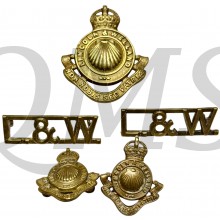Cap badge, shoulder titles and collar badges Lincoln & Welland Regiment, 4th Canadian Armoured Division
Between the wars, both the Lincoln Regiment and the Lincoln and Welland Regiment were greatly restricted in the training they were able to conduct. For example, the Lincoln Regiment trained 12 days in 1920, 9 days a year between 1922 and 1927, 12 days a year from 1928 to 1931 and 10 days a year from 1932 to 1936. On 15 December 1936, the two units were reorganized into The Lincoln and Welland Regiment with an establishment of 467 all ranks.
The regiment was called out on service on 26 August 1939 and then details were placed on active service on 1 September 1939, designated as The Lincoln and Welland Regiment, CASF (Details), for local protection duties. The details were formed as an active service battalion and designated The Lincoln and Welland Regiment, CASF on 15 August 1940. It was redesignated as the 1st Battalion, The Lincoln and Welland Regiment, CASF on 7 November 1940. The unit served in British Columbia, as part of the 13th Infantry Brigade, and in Newfoundland in a home defence role as part of Atlantic Command. On 16 July 1943 the 1st Battalion it embarked for Britain. On 25 July 1944 it landed in France as a part of the 10th Infantry Brigade, 4th Canadian Armoured Division, and it continued to fight in North-West Europe until the end of the war. The overseas battalion was disbanded on 15 February 1946.
The highest and most distinguished award for valour, the Order of the Bronze Lion was bestowed upon the regiment's Sergeant Wallace Edmond Firlotte.
From Tilly-la-Campagne on 31 July 1944 until Bad Zwischenahn on 1 May 1945, the regiment distinguished itself in many actions. Over 1500 men of the regiment were casualties. Of the original men who enlisted in 1940, only three officers and 22 men were on parade in St. Catharines in 1946 when the 1st Battalion was dismissed.


